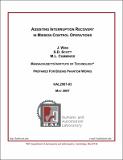| dc.description.abstract | Frequent interruptions are commonplace in modern work environments. The negative
impacts of interruptions are well documented and include increased task completion and
error rates in individual task activities, as well as interference with team coordination in
team-based activities. The ramifications of an interruption in mission control operations,
such as military command and control and emergency response, can be particularly costly
due to the time and life-critical nature of these operations. The negative impacts of
interruptions have motivated recent developments in software tools, called interruption
recovery tools, which help mitigate the effects of interruptions in a variety of task
environments. However, mission control operations introduce particular challenges for
the design of these tools due to the dynamic and highly collaborative nature of these
environments.
To address this issue, this report investigates methods of reducing the negative
consequences of interruptions in complex, mission control operations. In particular, this
report focuses on supporting interruption recovery for team supervisors in these
environments, as the research has shown that supervisors are particularly susceptible to
frequent interruptions. Based on the results of a requirements analysis, which involved a
cognitive task analysis of a representative mission control task scenario, a new
interruption recovery tool, named the Interruption Recovery Assistance (IRA) tool, was
developed. In particular, the IRA tool was designed to support a military mission
commander overseeing a team of unmanned aerial vehicle (UAV) operators performing
ground force protection operations. The IRA tool provides the mission commander a
visual summary of mission changes, in the form of an event bookmark timeline. It also
provides interactive capabilities to enable the commander to view additional information
on the primary task displays when further detail about a particular mission event is
needed.
The report also presents the findings from a user study that was conducted to evaluate the
effectiveness of the IRA tool on interruption recovery during collaborative UAV mission
operations. The study produced mixed results regarding the effectiveness of the IRA tool.
The statistical analysis indicated a negative impact on recovery time, while indicating a
positive impact on decision accuracy, especially in complex task situations. The study
also indicated that the effect of the IRA tool varied across differ user populations. In
particular, the IRA tool tended to provide greater benefits to participants without military
experience, compared to military participants involved in the study. The qualitative
findings from the study provided key insights into the impact and utility of the IRA tool.
These insights were used to identify several future research and design directions related
to interruption recovery in mission control operations. | en |
